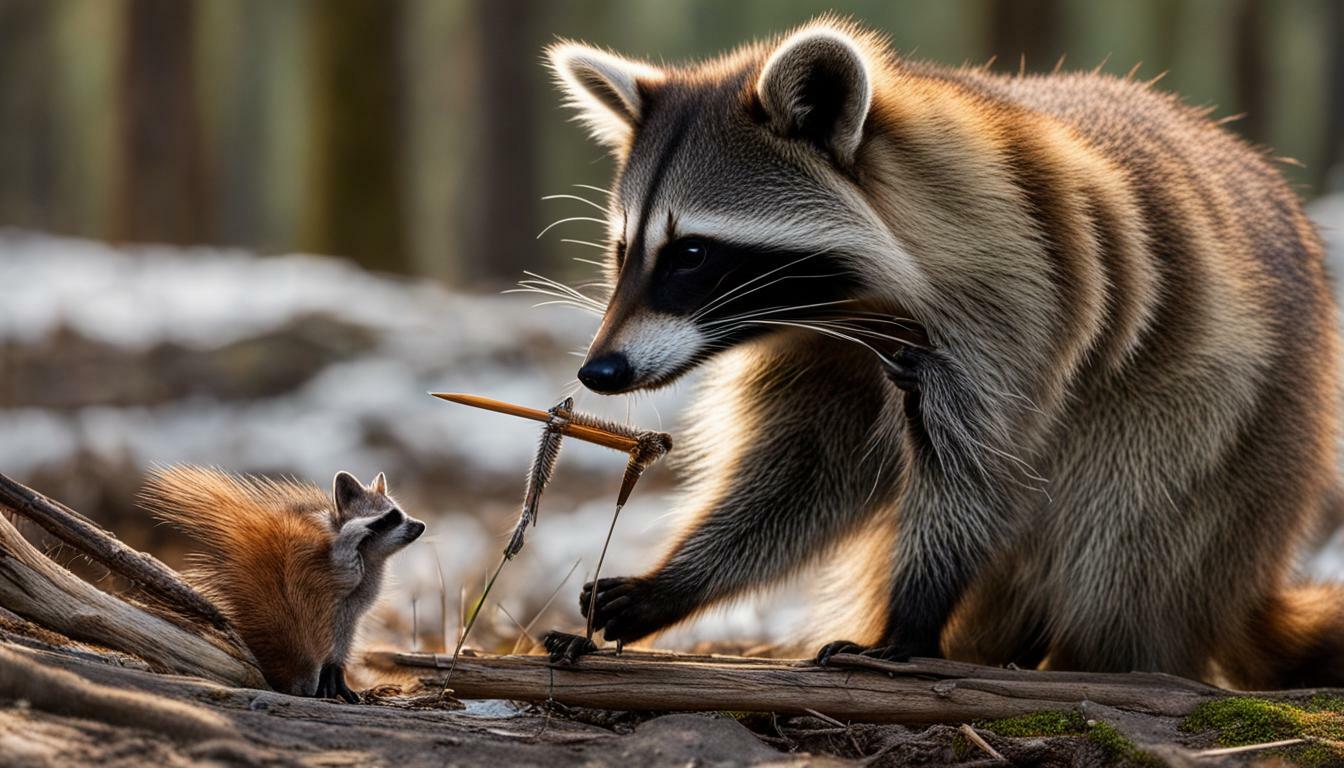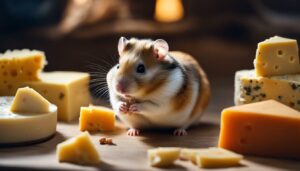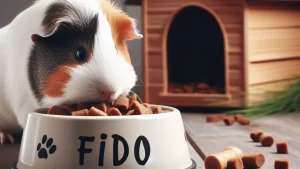Wild animals have developed unique strategies for removing porcupine quills and protecting themselves from harm. When faced with an encounter with a porcupine, these animals have evolved natural quill removal methods to ensure their survival. Understanding how wild animals handle such encounters can provide insight into their resilience and adaptation.
Key Takeaways:
- Wild animals have unique mechanisms for removing porcupine quills.
- They use a release mechanism that drives the quills inward and breaks them free.
- To remove quills, firm but delicate pulling with needle-nose pliers is recommended.
- If a quill breaks off, it usually works its way out naturally.
- The antibiotic coating on quills helps reduce the risk of infection.
Wild Animal Quill Removal Mechanisms
Wild animals possess specialized defense mechanisms that aid in the removal of porcupine quills. When faced with a quilled predator, these animals have developed ingenious ways to protect themselves and remove the sharp quills embedded in their skin. By triggering a release mechanism, wild animals are able to free themselves from the quills and ensure their survival.
One of the primary defense mechanisms employed by wild animals is to tense up when quilled. This muscle contraction causes the quills to be driven inward, breaking free from the connective tissue and lodging into the predator’s skin. This reaction allows the animal to escape and avoid further injury.
To remove quills from an animal, it is best to approach the task with caution and care. Using needle-nose pliers, gently grasp the quill as close to the skin as possible. Firmly but delicately pull the quill straight out, being mindful not to twist or bend it. This method reduces the risk of breaking the quill and causing further complications.
| Quill Removal Tips: |
|---|
| Approach with caution |
| Use needle-nose pliers |
| Grasp close to the skin |
| Pull straight out |
In some cases, a quill may break off during removal. However, there is no cause for immediate concern. Broken quills generally work their way out naturally over time. This process is facilitated by the antibiotic coating found on porcupine quills, which helps reduce the chance of infection and aids in the healing process.
Seeking Veterinary Assistance
While removing quills can often be done safely and effectively, there are instances where veterinary assistance is necessary. Particularly if the quills are located near sensitive areas such as the eyes or throat, it is advisable to seek professional help. Veterinarians have the knowledge, experience, and proper tools to ensure the animal’s safety and minimize any potential risks or complications.
Pulling Out Quills with Needle-Nose Pliers
The most common method of removing porcupine quills from wild animals is by carefully pulling them out with the help of needle-nose pliers. This technique requires a firm yet delicate approach to avoid causing further harm or injury to the animal. The following steps outline the proper procedure for quill removal in the wild:
- Restrain the animal: Take necessary precautions to safely restrain the animal, ensuring minimal stress and injury.
- Position the pliers: Gently grip the base of the quill with the needle-nose pliers, as close to the skin as possible.
- Pull firmly and steadily: Apply a steady pulling motion in the direction opposite to the quill’s entry, maintaining a firm grip without jerking or twisting.
- Remove broken quills: If a quill breaks off during the process, it is best to leave it be as it will likely work its way out naturally over time.
It is important to note that this method should only be used for quills located in accessible areas and when dealing with non-life-threatening situations. If quills are embedded near sensitive areas such as the eyes, throat, or vital organs, it is crucial to seek veterinary assistance to ensure the animal’s safety and prevent further complications.
While pulling out quills with needle-nose pliers is a common technique, it is imperative to handle the situation with care and respect for the animal’s well-being. By following these guidelines, one can help alleviate the discomfort and potential risks associated with porcupine quill injuries in the wild.
| Key Points: |
|---|
| The most common method for removing porcupine quills from wild animals is using needle-nose pliers |
| Firm yet delicate grip needed to avoid further injury |
| Procedure: Restrain the animal, position the pliers, pull firmly and steadily |
| Quills near sensitive areas may require professional veterinary assistance |
Handling Broken Quills
In case of broken quills, animals rely on their natural expulsion process to remove the remaining pieces. When quills break off inside an animal’s skin, the body recognizes them as foreign objects, triggering a mechanism to gradually push them out. This process may take some time, but it is an effective way for animals to rid themselves of broken quills.
The antibiotic coating on porcupine quills plays a crucial role in minimizing the risk of infection. This natural defense mechanism helps protect the animal from harmful bacteria that may enter through the broken quill sites. The antibiotic coating not only acts as a protective barrier but also aids in the healing process as the quills are expelled.
While waiting for the broken quills to work their way out, it is important to monitor the animal closely for any signs of discomfort or infection. Keeping the area clean and providing a stress-free environment can promote faster healing. If any concerns arise or the animal’s condition worsens, it is recommended to seek veterinary assistance promptly.
| Broken Quill Handling Tips: |
|---|
| Monitor the animal for signs of discomfort or infection. |
| Keep the broken quill area clean to minimize the risk of infection. |
| Provide a stress-free environment to promote faster healing. |
| Seek veterinary assistance if any concerns arise or the animal’s condition worsens. |
In summary, when animals experience broken quills, they rely on their natural expulsion process to remove the remaining pieces. The antibiotic coating on porcupine quills helps protect against infection and supports the healing process. By closely monitoring the animal, keeping the area clean, and providing a stress-free environment, we can help facilitate the natural removal of broken quills. However, it is essential to seek veterinary assistance if any concerns or complications arise.
Seeking Veterinary Assistance for Porcupine Quill Removal Techniques
In certain situations, it is crucial to seek veterinary assistance for the safe and effective removal of porcupine quills. While wild animals have their own natural mechanisms for removing quills, certain cases may require professional help to ensure the animal’s well-being. This is especially true when the quills are located near sensitive areas such as the eyes or throat.
When dealing with quills near these sensitive areas, it is important to approach the situation with caution and expertise. Veterinary professionals have the necessary experience and knowledge to navigate these delicate procedures. They can provide sedation and pain management to alleviate the animal’s discomfort during removal.
In addition to the physical aspects of quill removal, seeking veterinary assistance can also help prevent further complications. If quills are left untreated or not removed properly, they can lead to infections or abscesses. Veterinary experts can ensure that the quills are completely removed and provide any necessary treatment to prevent infections from occurring.
| Benefits of Seeking Veterinary Assistance for Quill Removal |
|---|
| Expertise in handling delicate procedures |
| Ability to provide sedation and pain management |
| Prevention of further complications or infections |
By seeking veterinary assistance, we can ensure that the removal process is conducted safely and effectively. This not only protects the animal from unnecessary pain and discomfort but also helps to promote a quicker recovery. When dealing with porcupine quills near sensitive areas or in more serious cases, it is best to trust the expertise of veterinary professionals to ensure the well-being of the wild animal.
Avoiding Infection
The antibiotic coating present on porcupine quills plays a vital role in minimizing the chances of infection. When a wild animal gets stuck with quills, it triggers a release mechanism that causes the quills to be driven inward, break free from the connective tissue, and lodge into the predator’s skin. To remove these quills, it is important to be firm yet delicate, using needle-nose pliers. By gently pulling the quills out, we can prevent further injury and discomfort to the animal.
If a quill happens to break off during the removal process, there is no immediate cause for alarm. Broken quills typically work their way out of the animal’s skin over time. This natural process of quill expulsion helps prevent infection and allows for proper healing. The antibiotic coating on the quills further aids in reducing the risk of infection, acting as a protective barrier against harmful bacteria.
However, it’s crucial to exercise caution when dealing with quills near sensitive areas, such as the eyes or throat. In such cases, it is advisable to seek veterinary assistance. Veterinarians have the expertise and tools necessary to safely remove the quills without causing additional harm to the animal. Their knowledge and experience ensure that the animal’s well-being is prioritized and that any potential complications are managed effectively.
| Key Points | Benefits |
|---|---|
| The antibiotic coating on porcupine quills helps minimize the risk of infection. | Prevents harmful bacteria from entering the animal’s body. |
| Gently pulling quills out with needle-nose pliers is recommended. | Minimizes further injury and discomfort for the animal. |
| Broken quills will naturally work their way out over time. | Prevents infection and allows for proper healing. |
| Veterinary assistance is crucial for quill removal near sensitive areas. | Ensures the animal’s safety and prevents complications. |
Quill Removal Near Sensitive Areas
Quill removal near sensitive areas requires careful handling and professional assistance to avoid potential harm. When dealing with quills located around the eyes or throat, it is crucial to prioritize the safety and well-being of the animal. Attempting to remove quills from these areas without the necessary expertise can lead to further complications and increased risk of injury.
For quills near the eyes, where even slight damage can have severe consequences, it is strongly recommended to seek veterinary assistance. Veterinarians have the knowledge, skills, and specialized equipment to handle delicate procedures like quill removal near sensitive areas. They can ensure that the process is done safely and efficiently, minimizing the risk of harm to the animal.
Similarly, quills lodged in or around the throat require professional attention. These areas are particularly sensitive, and the risk of injury increases significantly if removal is attempted without proper expertise. Veterinary assistance is essential to prevent complications such as further quill migration, damage to vital structures, or accidental injury to the animal during the removal process.
By seeking expert help for quill removal near sensitive areas, animal owners can ensure the best possible outcome for their furry companions. The experience and expertise of veterinarians play a vital role in minimizing pain, reducing the risk of injury or infection, and promoting a speedy recovery. When it comes to delicate procedures like quill removal, entrusting the task to professionals is always the safest and most responsible approach.
Animal Resilience and Adaptation
Wild animals have evolved remarkable resilience and adaptation strategies to cope with the presence of porcupine quills. These quills are designed to deter predators and can cause significant harm if not properly dealt with. However, nature has equipped many species with mechanisms to remove and minimize the impact of these quills.
One fascinating adaptation is the release mechanism that is triggered when animals tense up upon contact with porcupine quills. This muscular response causes the quills to be driven inward, breaking free from the connective tissue and embedding themselves into the predator’s skin. This not only limits the depth of penetration but also reduces the risk of further injury. The quills are then gradually expelled through natural processes, aided by the antibiotic coating on the quills, which helps protect against infection.
When dealing with porcupine quills, it is crucial to approach removal with care and precision. The recommended method involves using needle-nose pliers to firmly but delicately pull out the quills. The process requires a steady hand and patience to ensure that all quills are completely removed, as leaving even a single quill behind can lead to pain, infection, and potential complications.
In more serious cases or when quills are located near sensitive areas such as the eyes or throat, it is advisable to seek veterinary assistance. Veterinarians have the expertise and tools necessary to safely remove quills and provide appropriate medical care, reducing the risk of further harm to the animal.
| Key Takeaways: |
|---|
| – Wild animals have evolved resilience and adaptation strategies to deal with porcupine quills. |
| – A release mechanism is triggered when animals tense up, causing the quills to break free and embed themselves into the predator’s skin. |
| – Needle-nose pliers are recommended for quill removal, ensuring a firm yet delicate approach. |
| – Veterinary assistance should be sought in more serious cases or when quills are near sensitive areas. |
The Importance of Quill Removal
Prompt removal of porcupine quills is crucial to safeguard the health and safety of wild animals. When a predator encounters a porcupine, the quills become embedded in the predator’s skin as a defense mechanism. In response, wild animals have developed unique methods for removing these quills to minimize the risk of infection or injury.
Quill removal should be approached with caution and care to prevent further complications. Using needle-nose pliers, the quills can be firmly but delicately pulled out, ensuring the entire quill is extracted without leaving any fragments behind. It is important to avoid twisting or jerking the quills, as this may cause them to break off.
If a quill does break off during the removal process, there is usually no cause for immediate concern. The animal’s natural healing process will work to expel the broken quill over time. Additionally, the antibiotic coating on porcupine quills helps to reduce the risk of infection, providing a natural defense against potential complications.
However, in more serious cases or if the quills are located near sensitive areas such as the eyes or throat, it is highly advisable to seek veterinary assistance. Veterinary professionals have the expertise and tools necessary to safely remove quills from these delicate areas, minimizing the risk of further injury and ensuring the animal’s well-being.
| Summary: | Prompt removal of porcupine quills is crucial to safeguard the health and safety of wild animals. Quills can be safely removed using needle-nose pliers, being careful not to break them. The animal’s natural healing process and the antibiotic coating on the quills aid in the removal and reduce the risk of infection. In cases involving sensitive areas or serious injuries, seeking veterinary assistance is strongly recommended. |
|---|
Nature’s Survival Tactics: Wild Animals and Porcupine Quill Removal
Nature’s survival tactics are demonstrated through the various strategies animals employ to remove and protect themselves from porcupine quills. These quills, with their sharp barbs, can be a formidable defense mechanism for porcupines, but many wild animals have evolved fascinating methods to deal with this challenge.
When faced with a porcupine’s quills, wild animals have developed a unique release mechanism. As they tense up, the quills are driven inward, allowing them to break free from the connective tissue and lodge into the predator’s skin. This mechanism serves as a defense strategy for the porcupine, but it also presents a problem for the predator.
To remove the quills, animals often rely on their own resourcefulness. One recommended method is to pull out the quills firmly but delicately using needle-nose pliers. This requires a balance of strength and finesse to minimize the risk of further injury and ensure the quills are completely removed.
| Wild Animal Quill Removal Steps |
|---|
| Step 1: Approach the animal calmly and gently restrain it, if necessary. |
| Step 2: Use needle-nose pliers to grip the quill as close to the skin as possible. |
| Step 3: Firmly and steadily pull the quill out in the direction it entered. |
| Step 4: Dispose of the quills safely to prevent injury to yourself or others. |
“It is crucial to exercise caution and seek professional help in more serious cases or if the quills are located near sensitive areas, such as the eyes or throat. Veterinary assistance ensures the animal’s safety and prevents further complications.”
In cases where a quill breaks off, animals have their own natural mechanism to handle the situation. Over time, broken quills typically work their way out of the skin as the animal’s body heals. Furthermore, the antibiotic coating on porcupine quills helps reduce the chance of infection, providing an additional layer of protection for the animal.
Wild animals’ ability to adapt and overcome challenges such as porcupine quills highlights nature’s remarkable resilience. Through their unique survival tactics, these animals navigate the intricacies of their environment, demonstrating the incredible diversity and complexity of the natural world.
The Fascinating World of Animal Defense
The animal kingdom showcases an array of fascinating defense mechanisms employed to deal with the threat of porcupine quills. From the intricate adaptive behaviors of wild animals to their remarkable resilience, nature has devised ingenious ways to protect itself in the face of this prickly challenge.
One compelling defense mechanism observed in the wild involves a release mechanism triggered when predators or curious animals come into contact with porcupine quills. When a predator tenses up, the quills are driven inward, breaking free from the connective tissue and lodging into their skin. This adaptive response effectively immobilizes the quills, making it difficult for predators to shake them off.
When it comes to quill removal, many wild animals have evolved the remarkable ability to delicately pull out the quills with needle-nose pliers. By firmly but gently grasping the quill close to the skin, they avoid further injury and ensure a successful removal process. However, it is essential to exercise caution and seek expert assistance in cases where the quills are located near sensitive areas such as the eyes or throat.
| Key Points: |
|---|
| – Wild animals have developed adaptive behaviors to remove porcupine quills effectively. |
| – Quills are driven inward, breaking free from connective tissue and lodging into the predator’s skin. |
| – Animals use delicate techniques, such as pulling out quills with needle-nose pliers, to safely remove quills. |
| – Caution is advised when dealing with quills near sensitive areas, and veterinary assistance should be sought if necessary. |
In cases where a quill becomes broken off, animals have a natural process of quill expulsion. Over time, the broken quill will typically work its way out of the skin, aided by the antibiotic coating that covers porcupine quills. This coating helps reduce the risk of infection and contributes to the healing process, showcasing yet another remarkable adaptation of these quills.
The awe-inspiring world of animal defense never ceases to amaze. From the intricate mechanisms triggered within the animal’s body to the remarkable strategies employed for quill removal, the animal kingdom continues to demonstrate its resilience and adaptability. It is a testament to the ongoing struggle for survival and the marvels of nature’s ingenuity.
Key Takeaways:
- Wild animals employ fascinating defense mechanisms to deal with porcupine quills.
- A release mechanism triggers quill lodging into predator’s skin.
- Delicate techniques, such as pulling out quills with needle-nose pliers, are used for quill removal.
- Quill expulsion occurs naturally if a quill breaks off, aided by the antibiotic coating on the quills.
- The animal kingdom demonstrates remarkable resilience and adaptability in the face of porcupine quills.
The animal kingdom’s response to porcupine quills highlights the dynamic and multifaceted world of defense strategies. As we continue to explore and learn from nature, we gain a deeper appreciation for the remarkable adaptations that enable wild animals to thrive in their environments.
Conclusion
The removal of porcupine quills by wild animals showcases their remarkable resilience and adaptation, while also highlighting the significance of expert assistance in certain situations.
When faced with the challenge of quill removal, wild animals have developed ingenious defense mechanisms. Through a release mechanism triggered by tension, these animals can drive the quills deeper into their own skin, breaking free from the connective tissue and lodging into their predator’s skin. This unique adaptation allows them to protect themselves and survive in their natural habitats.
For those seeking to remove quills from an animal, it is important to approach the task with care. Needle-nose pliers are recommended for pulling out the quills, employing a firm yet delicate grip to avoid causing further harm. However, in cases where quills are broken off, there is no cause for immediate alarm. The broken quills will typically work their way out naturally over time, aided by the antibiotic coating present on porcupine quills that helps reduce the risk of infection.
While some quill removal can be done by individuals, it is essential to recognize the limits and complexities of the situation. In more serious cases or when the quills are located near sensitive areas such as the eyes or throat, it is advisable to seek veterinary assistance. Professionals possess the expertise and tools necessary to ensure the animal’s safety and prevent further complications.
In conclusion, the fascinating world of wild animal quill removal highlights the resilience and adaptation of these creatures. Their ability to overcome challenges and adapt to their environment is truly remarkable. However, it is crucial to remember the importance of expert assistance when needed, ensuring the well-being and recovery of these incredible creatures.
FAQ
How do wild animals remove porcupine quills?
Wild animals remove porcupine quills using a release mechanism that is triggered when they tense up. This causes the quills to be driven inward, break free from the connective tissue, and lodge into the predator’s skin.
What is the best way to remove quills from an animal?
It is best to pull out the quills firmly but delicately with needle-nose pliers. This ensures effective removal without causing further harm to the animal.
What should I do if a quill breaks off?
If a quill breaks off, it will typically work its way out eventually. The antibiotic coating on the quills helps reduce the chance of infection during this process.
When should I seek veterinary assistance for quill removal?
If the quills are located near sensitive areas such as the eyes or throat, or if the situation is more serious, it is advisable to seek veterinary assistance. Veterinarians have the necessary expertise to handle these cases safely and effectively.
How can I avoid infection when removing quills?
The antibiotic coating on porcupine quills helps reduce the chance of infection. However, it is important to handle the quills with care and maintain proper hygiene to minimize the risk of infection.




